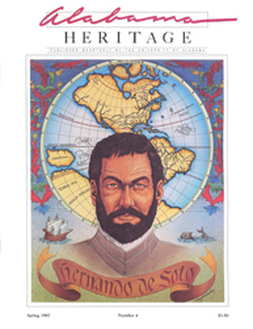|
On the cover: Illustration by Terry Henderson; map after Mercator (1595).
Although this issue is no longer in print, scroll down to find some features from this issue that are available for purchase as downloadable PDFs.
|
FEATURE ABSTRACTS
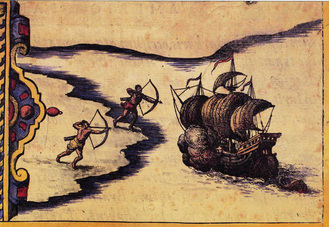 Detail from a map of the New World by Jode, 1593.
Detail from a map of the New World by Jode, 1593. (Courtesy W.S. Hoole Special Collections Library,
University of Alabama)
The Spanish Heritage of the Southeast
By Lawrence A. Clayton
At first glance, the idea of a Spanish heritage in the Southeast seems strange. Southerners speak English, not Spanish., Most trace their religious roots to Protestant England rather than to Catholic Spain. But, as Lawrence Clayton points out, the story of the South could have been very different. Spaniards were the first Europeans to explore this part of the world. Had they been adventurers and colonists of a different type with goals other than those they had, the American South might have a different heritage today. Some of the reasons it does not can be found in the story of the Spanish conquistadors in Alabama and the Southeast--in what they sought, what they found, and what they left behind.
Additional Information
About the Author
Larry Clayton, a New Jersey native, spent much of his youth in Peru, where his father was employed by W. R. Grace & Co., the first multinational corporation in Latin America. After graduating from Duke University in 1964, Clayton completed a master's degree and doctorate in Latin American history at Tulane University. He joined the University of Alabama history faculty in 1972 and has directed the university's Latin American Studies Program since 1980.
Clayton has published widely on Latin American history and is currently writing a textbook on the subject for Harcourt, Brace, Jovanovich. His most recent book is Grace: W. R. Grace & Co., the Formative Years, 1850-1930, published by Jameson Books in 1986.
By Lawrence A. Clayton
At first glance, the idea of a Spanish heritage in the Southeast seems strange. Southerners speak English, not Spanish., Most trace their religious roots to Protestant England rather than to Catholic Spain. But, as Lawrence Clayton points out, the story of the South could have been very different. Spaniards were the first Europeans to explore this part of the world. Had they been adventurers and colonists of a different type with goals other than those they had, the American South might have a different heritage today. Some of the reasons it does not can be found in the story of the Spanish conquistadors in Alabama and the Southeast--in what they sought, what they found, and what they left behind.
Additional Information
- Badger, R. Reid, and Lawrence A. Clayton, eds. Alabama and the Borderlands: From Prehistory to Statehood (University of Alabama Press, 1985).
- Bannon, John Francis. The Spanish Borderlands Frontier, 1513-1821 (Holt, Rinehart and Winston, 1970).
- Bolton, Herbert E. The Spanish Borderlands (Yale University Press, 1921).
- Hemming, John. The Conquest of the Incas (Harcourt, Brace, Jovanovich, 1970).
- Keen, Benjamin, ed. Latin American Civilization: History and Society, 1492 to the Present, 4th ed. (Westview Press, 1986).
- Pagden, A. R., trans. and ed. Hernán Cortés: Letters from Mexico (Grossman, 1971).
- Priestley, Herbert I. Tristán de Luna: Conquistador of the Old South: A Study of Spanish Imperial Strategy (Arthur H. Oark, 1936).
- Sanderlin, George, trans. and ed. Bartolomé de Las Casas: A Selection of his Writings (Knopf, 1971).
- Sauer, Carl Ortwin. Sixteenth Century North America: The Land and People as Seen by the Europeans (University of California Press, 1971).
About the Author
Larry Clayton, a New Jersey native, spent much of his youth in Peru, where his father was employed by W. R. Grace & Co., the first multinational corporation in Latin America. After graduating from Duke University in 1964, Clayton completed a master's degree and doctorate in Latin American history at Tulane University. He joined the University of Alabama history faculty in 1972 and has directed the university's Latin American Studies Program since 1980.
Clayton has published widely on Latin American history and is currently writing a textbook on the subject for Harcourt, Brace, Jovanovich. His most recent book is Grace: W. R. Grace & Co., the Formative Years, 1850-1930, published by Jameson Books in 1986.
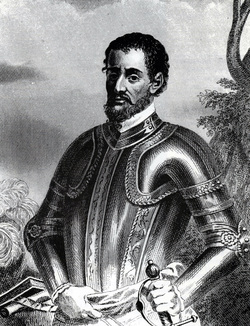 Hernando De Soto (Courtesy
Hernando De Soto (CourtesyW.S. Hoole Special Collections
Library, University of Alabama)
The Search for Hernando De Soto
By John C. Hall
Hernando De Soto's entrada, perhaps more than other Spanish expeditions into the southern United States, has captured the imagination of scholars and the public alike for a number of reasons, primarily because the possibility of correlating De Soto's accounts with the landscape of the South would provide a wealth of historical detail. This article chronicles the search for Hernando De Soto's campsites.
Additional Information
About the Author
John Hall, program coordinator for the Alabama State Museum of Natural History, emphatically disavows being an expert on anything. He studied geology and biology as an undergraduate, taught high school science for several years, and recently completed his doctorate in education at the University of Alabama. Since 1978 Hall has been program coordinator for the State Museum of Natural History, where he supervises educational programs, manages the natural history collections, and leads the museum's summer expeditions.
Hall first became interested in the search for De Soto in 1979 when the museum supported archaeologist Caleb Curren's De Soto project in Tuscaloosa and Hale counties. He has been hooked ever since.
The author wishes to thank Vernon James Knight and Caleb Curren for their assistance with this article.
By John C. Hall
Hernando De Soto's entrada, perhaps more than other Spanish expeditions into the southern United States, has captured the imagination of scholars and the public alike for a number of reasons, primarily because the possibility of correlating De Soto's accounts with the landscape of the South would provide a wealth of historical detail. This article chronicles the search for Hernando De Soto's campsites.
Additional Information
- Badger, R. Reid, and Lawrence A. Clayton, eds. Alabama and the Borderlands: From Prehistory to Statehood (University of Alabama Press, 1985).
- Bourne, Edward G., ed. Narratives of the Career of Hernando de Soto, 2 vols. (Allerton, 1904).
- Hudson, Charles. The Southeastern Indians (University of Tennessee Press, 1976).
- Smith, M. T., ed. The De Soto Expedition: New Perspectives (University of Florida, volume in preparation).
- Swanton, John R. Final Report of the United States De Soto Expedition Commission, introduction by Jeffrey P. Brain (1939; reprint, Smithsonian Institution Press, 1985).
About the Author
John Hall, program coordinator for the Alabama State Museum of Natural History, emphatically disavows being an expert on anything. He studied geology and biology as an undergraduate, taught high school science for several years, and recently completed his doctorate in education at the University of Alabama. Since 1978 Hall has been program coordinator for the State Museum of Natural History, where he supervises educational programs, manages the natural history collections, and leads the museum's summer expeditions.
Hall first became interested in the search for De Soto in 1979 when the museum supported archaeologist Caleb Curren's De Soto project in Tuscaloosa and Hale counties. He has been hooked ever since.
The author wishes to thank Vernon James Knight and Caleb Curren for their assistance with this article.
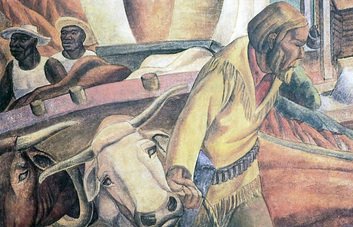 Detail of "Shipment of First Iron Produced in Russellville,"
Detail of "Shipment of First Iron Produced in Russellville,"a fresco by Conrad Albrizio, completed in 1938. (Photo courtesy
Chip Cooper)
The Battle of the Beehive Furnace Mural: Russellville, Alabama
By Robert Mitchell
On the north wall of the Russellville post office is a mural: laborers working around a massive beehive iron furnace. The painting seems like an unlikely target for controversy, but in the 1930s it was the center of a conflict that eventually involved the Speaker of the US.House of Representatives. The debate was, ultimately, about more than the mural's subject matter; at its heart is the question of ownership. To whom does federally supported public art belong?
By Robert Mitchell
On the north wall of the Russellville post office is a mural: laborers working around a massive beehive iron furnace. The painting seems like an unlikely target for controversy, but in the 1930s it was the center of a conflict that eventually involved the Speaker of the US.House of Representatives. The debate was, ultimately, about more than the mural's subject matter; at its heart is the question of ownership. To whom does federally supported public art belong?
Additional Information
About the Author
Bob Mitchell (1937-1986) was a member of the University of Alabama history faculty from 1967 until his untimely death last August. Mitchell, an Atlanta native, received his B.S. degree from Georgia Southern College, and his M.A. and Ph.D. degrees from Tulane University. A specialist in Southern colonial history, he published numerous articles on the American Revolution in the South. Recently he had become interested in the federal art patronage programs of the 1930s and had spent time in the National Archives researching the Alabama post office murals commissioned by the Section of Painting and Sculpture. In preparing for this article, Mitchell also interviewed Mr. and Mrs. Charles Underwood, longtime residents of Russellville, and he wished to thank them publicly for their assistance.
The editors would like to thank Russellville Postmaster Jimmy Ross Seay for his help in obtaining photographs for this article.
- Bruce, Edward, and Forbes Watson. Art in Federal Buildings (John D. Lucas Printing Company, 1936).
- Contreras, Belisario R. Tradition and Innovation in New Deal Art (Bucknell University Press, 1983).
- McKinzie, Richard D. The New Deal for Artists, (Princeton University Press, 1973).
- Marling, Karat Ann. Wall-to-Wall America, A Cultural History of Post-Office Murals in the Great Depression (University of Minnesota Press, 1982).
- Mecklenburg, Virginia. The Public as Patron (University of Maryland, Department of Art, 1979).
- Park, Marlene, and Gerald Markowitz. Democratic Vistas: Post Offices and Public Art in the New Deal (Temple University Press, 1984).
- The National Archives, Washington, D.C., Record Group 121, Inventory Entry 133, Case Files Concerning Embellishments of Federal Buildings, 1934-43, Boxes 1 and 2, Alabama.
About the Author
Bob Mitchell (1937-1986) was a member of the University of Alabama history faculty from 1967 until his untimely death last August. Mitchell, an Atlanta native, received his B.S. degree from Georgia Southern College, and his M.A. and Ph.D. degrees from Tulane University. A specialist in Southern colonial history, he published numerous articles on the American Revolution in the South. Recently he had become interested in the federal art patronage programs of the 1930s and had spent time in the National Archives researching the Alabama post office murals commissioned by the Section of Painting and Sculpture. In preparing for this article, Mitchell also interviewed Mr. and Mrs. Charles Underwood, longtime residents of Russellville, and he wished to thank them publicly for their assistance.
The editors would like to thank Russellville Postmaster Jimmy Ross Seay for his help in obtaining photographs for this article.
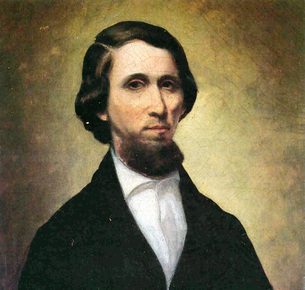 Johnson Jones Hooper, creator of Simon Suggs.
Johnson Jones Hooper, creator of Simon Suggs.(Courtesy Alabama Dept. of Archives and History)
Mr. Spirit and His Alabama Wits
By Eugene Current-Garcia
William Trotter Porter--also known as "Mr. Spirit" or "The Tall Son of York"--used his New York sporting journal Spirit of the Times to bring attention to a new type of American literature: Southwestern frontier humor. Porter ennobled a new class of writers. With his help, the authors he published were able to bring new zest and vigor to American fiction. This article recounts the story of Porter and his top authors. It includes two excerpts by J.J. Hooper and John Gorman Barr, both published by Porter.
By Eugene Current-Garcia
William Trotter Porter--also known as "Mr. Spirit" or "The Tall Son of York"--used his New York sporting journal Spirit of the Times to bring attention to a new type of American literature: Southwestern frontier humor. Porter ennobled a new class of writers. With his help, the authors he published were able to bring new zest and vigor to American fiction. This article recounts the story of Porter and his top authors. It includes two excerpts by J.J. Hooper and John Gorman Barr, both published by Porter.
Additional Information
About the Author
Eugene Current-Garcia, Hargis Professor Emeritus of American Literature at Auburn University, joined the Auburn faculty in 1947 after completing undergraduate and master's degrees at Tulane University and a Ph.D. in American literature at Harvard University. Professor Current-Garcia has written and edited numerous books and articles on American short fiction, including O. Henry (1965), and his latest book, The American Short Story before 1850: A Critical History (1985), both by Twayne Publishers.
- Barr, John Gorman. Rowdy Tales from Early Alabama: The Humor of John Gorman Barr. G. Ward Hubbs, ed. (University of Alabama Press, 1981).
- Brinley, Francis. Life of William T. Porter (D. Appleton and Company, 1860).
- Cohen, Hennig, and William B. Dillingham. Humor of the Old Southwest, second edition (University of Georgia Press, 1975).
- Current-Garcia, Eugene. "Newspaper Humor in the Old South, 1835-1855," The Alabama Review 2 (April 1949): 102-21.
- Hoole, W. Stanley. Alias Simon Suggs: The Life and Times of Johnson Jones Hooper (University of Alabama Press, 1952)
- Hooper, Johnson Jones. Some Adventures of Simon Suggs, reprint of 1845 edition (Irvington, n.d.).
- Hubbs, G. Ward. "Letters from John Gorman Barr," The Alabama Review 36 (October 1983): 271-84.
- Somers, Paul, Jr. Johnson J. Hooper, Twayne's United States Authors Series, no. 454 (Twayne, 1984).
About the Author
Eugene Current-Garcia, Hargis Professor Emeritus of American Literature at Auburn University, joined the Auburn faculty in 1947 after completing undergraduate and master's degrees at Tulane University and a Ph.D. in American literature at Harvard University. Professor Current-Garcia has written and edited numerous books and articles on American short fiction, including O. Henry (1965), and his latest book, The American Short Story before 1850: A Critical History (1985), both by Twayne Publishers.
